Case Management User Procedures
This chapter covers the following topics:
- About the Sample Case Management User Procedures
- Creating a Case
- Searching Cases
- Creating and Updating a Task
- Searching for Tasks
About the Sample Case Management User Procedures
Because user procedures and user interface configurations vary greatly from implementation to implementation, Oracle cannot provide end-user help for Case Management.
This chapter uses an example to provide application implementers and administrators with an introduction to typical user procedures for creating and resolving cases.
The example details how the fictitious Vision Enterprises creates a case to track a security breach at an airport.
The topics covered include:
Creating a Case
Security has just apprehended a passenger who was in the possession of a knife at the airport boarding gate.
-
Security agent Ted Crilly starts by searching the database for any information on the suspect.
-
Mr. Crilly selects the Party Search link located at the bottom right of the agent dashboard (highlighted in the partial image of the Agent Dashboard below.)
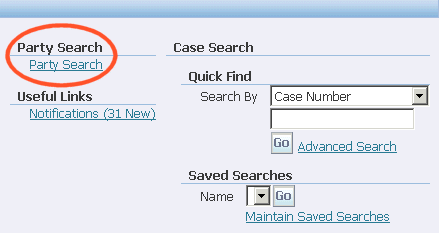
-
The Party Search page appears.

-
The agent chooses Person from the Search For drop-down list, enters any available identifying information about the suspect, and clicks Go.
In this example, the name the suspect has given "Andre Smith" yields three matches.
Additional search criteria are available in advanced search.
Note: If the suspect is unknown, the agent can choose an Unknown party that is set up by the application administrator. See Setting Up the Capture of Unknown Associated Parties.

-
Selecting the Name link displays more information about any of the parties in the database. Agent Crilly chooses the first name on the list based on the address the suspect has provided.

-
Agent Crilly verifies the basic information about the suspect on the Profile tab and addresses and contact points on the Address Book tab.
The Relationships And Classifications tab captures relationships between Andre Smith and other parties. It is here that Mr. Crilly could enter information about Smith's wife or children or his relationship to a criminal organization.
The Cases tab displays any other cases pending for the person. There are no pending cases against Andre Smith.
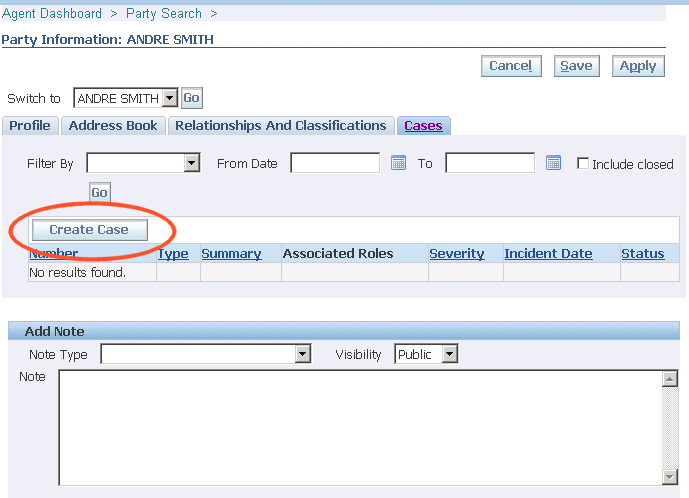
-
Mr. Crilly clicks the Create Case button to start the case creation process.
The Create Case: Define Role page appears.

-
From the Case Role drop-down list, agent Crilly chooses "Suspect" to indicate Andre Smith's role in the case.
The Create Case: Define Role page refreshes to display the additional attributes the application administrator has set up for this role.
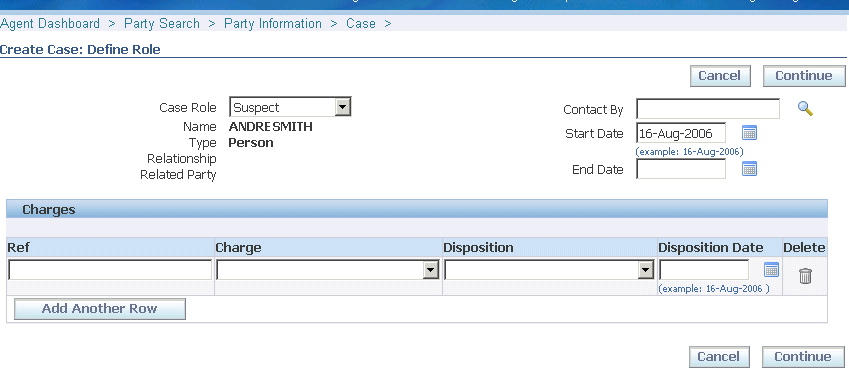
-
Mr. Crilly specifies the charges against the suspect in the fields provided. He can specify multiple charges by clicking the Add Another Row button.
Note: You can capture different information for each different role in the case by setting up extensible attributes. If there are any duplicate cases based on the additional attributes or the incident address, they will be displayed in a separate page. The agent can mark a case as a duplicate of this case.See Setting Up Associated Party Extensible Attributes.

-
Clicking Continue displays the Create Case: Provide Details page. (The following image shows only the upper left corner of the page.)
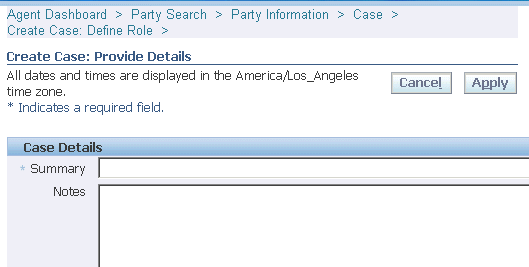
-
Mr. Crilly fills in the case summary in the Case Details region: "possession of knife at security gate", chooses "Security" as the note type and retains "Public" as the note visibility.
Note: : The default Note Type and Visibility are set in the profiles Service: Default New Note Type and Note: Default Note Status respectively. Mr. Crilly can change these values, if needed while creating the case.

-
Agent Crilly classifies the case by choosing the case type: "Security Investigation" and an issue type: "Weapon". For status, he chooses "Investigation".
Note: Issue types use the same setup as problem codes for service requests.

-
Because he is going to continue working on the case for the time being, Agent Crilly enters his name into the Individual Owner field.
Alternately, the agent can select a different assignment mode. The Assign Automatically option causes the application to assign the service request to the appropriate support group or to a specific agent, depending on how you set up your work assignment and distribution. If the Service: Real-Time Automatic Assignment of Service Requests in Agent-Facing Applications profile is set to Yes, then the Assign Automatically option is selected by default but if the profile is set to No, then the default value is Assign Manually.
Alternately, the agent can keep possession of the service request by choosing Assign to me and My Group option or keep ownership in her support group by choosing Assign to My Group, or may want to assign the service request manually to some other agent by choosing Assign Manually option.
If the assignment mode is manual, then the default values for Assigned Group and Individual Owner are displayed from the profiles Service: Default Group Owner for Service Requests and Service: Default Service Request Owner respectively, if they are defined.
-
He clicks Apply to create the case.
The application creates the case and displays it in the Update Case page. (The image below shows the top left hand side of the page only.)
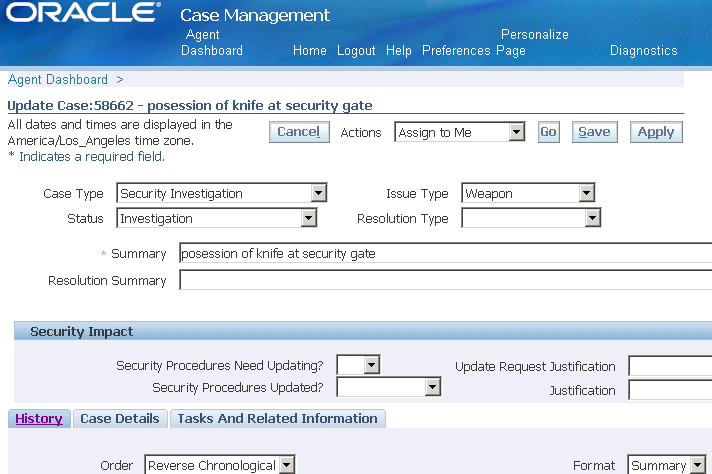
Agent Crilly is now ready to enter additional information from one of the security screeners who witnessed the incident.
-
In the Associated Parties region of the Case Details tab (shown in the image below), he chooses "Witness" from the Add drop-down list and clicks Go.

-
In the Party Search page, he chooses "Employee" as the witness is a fellow airport employee, and enters the name in the Party Search page. Clicking Go initiates the search.
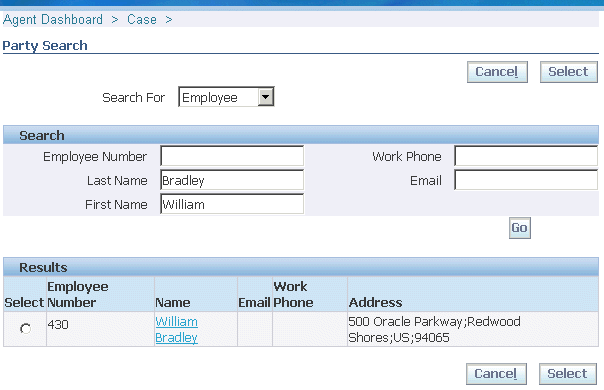
-
Mr. Crilly selects the employee using the Select radio button and clicks Select.
The application displays the Update Case page with the witness now associated to the case.
Note: You can capture additional information about the witness or any other associated party role by setting up extensible attributes. If you do, the application displays the Add Party Enter Attributes page requiring agents to make entries before returning to the Update Case page.

-
Crilly adds a note about what the witness reported at the bottom of the Case Update page.

-
Agent Crilly checks the Open Tasks for the case in the Dashboard region. Since there are no pending tasks, he generates a task for his associate.
-
Agent Crilly generates a task for his associate to investigate the suspect's background. He navigates to the Tasks And Related Information tab, chooses the task type, and clicks Go.

Note: You can set up task templates your agents can use to create tasks for common types of cases. You can have these tasks created automatically based on the case type, issue type and other attributes. See Generating Tasks Automatically.
The Task Creation page appears.
-
Agent Crilly enters the task and description and selects the Task Closure Required check box to ensure the case is not closed before this task is completed.

-
Mr. Crilly clicks Apply to create the task and returns to the Update Case page.
Note: The application automatically assigns the task to the appropriate agent based on service territories and availability. For details on setting up task assignment, see Implementing Work Assignment and Distribution.
Both the note and new task are recorded on the case History tab.
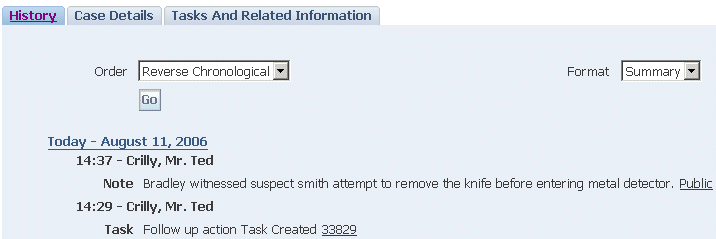
Note: By setting up notifications, you can have the application keep all the required parties automatically informed when the case is updated. SeeSetting Up Notifications.
-
Mr. Crilly clicks the Interaction tab and views the following interactions and activities.
When Interaction Activity Mr. Crilly creates the case Case is created Case Created Mr. Crilly updates the case Case is updated Case Updated Mr. Crilly updates the case with further details Case is updated Case Updated Mr. Crilly adds a task on the case Task is created A task is added He notes down the Interaction ID, Customer Name, Agent, Reason, Result, Outcome, and Start and End Dates.
Searching Cases
Case Management offers agents multiple ways of searching for cases from the Agent Dashboard.
This topic discusses:
Quick Find
The QuickFind feature makes it possible for you to find cases by case number.
Note: Some implementations may want to expose additional search criteria by modifying the lookup CSZ_SRCH_QUICKFIND_CODE_CASE. For details, see Case Management Lookups.
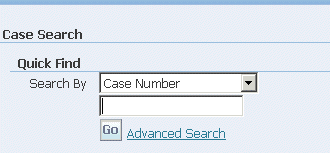
Advanced Searches
Selecting the Advanced Search link under QuickFind on the Agent Dashboard permits complex searches, including searches by the different party roles and party role attributes.
This section highlights two advanced searches:
-
A party search: What cases am I involved in?
-
An associated party search: What cases is employee Wiliam Bradley involved in as a witness where Andre Smith is the suspect?
What cases am I involved in?
William Bradley calls agent Crilly to get a list of all cases he is involved in.
-
On the Advanced Search page, agent Crilly first adds Employee Name as a search term by choosing it from the Add Attribute drop-down list and clicking Add.
Note: Using Oracle Applications Personalization you can eliminate this step and minimize user entries by specifying which search terms display as fields on the search page by default. This is possible for all search terms except for party roles and extensible attributes. See Personalizing the Advanced Search Page.
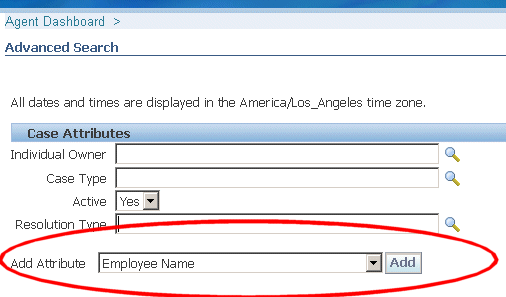
-
The agent enters the employee name and clicks Search.
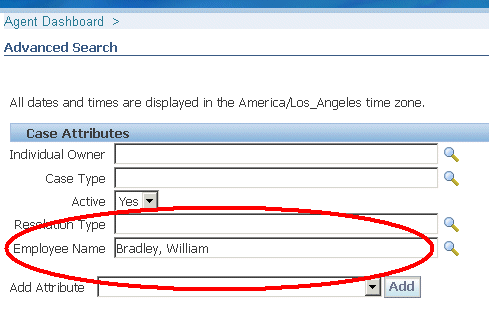
The application displays the results on the Advanced Search Results page.

In this example, Bradley is a witness in case 58460, the knife possession at the security gate case.
What cases is employee William Bradley involved in as a witness where Andre Smith is the suspect?
You can also search for cases involving one or more associated parties with specific roles. Here is how agent Crilly searches for all the cases where employee William Bradley is a witness and Andre Smith is a suspect.
-
On the Advanced Search page, Crilly clicks Add Party (the button highlighted in the image below).

The Party Search page appears.
-
To add "William Bradley", he chooses "Employee" from the Search For drop-down list and enters the name.

-
Clicking Go performs the search and displays the results.
-
Agent Crilly selects the record: selecting the Select radio button (region 1 in the image below) and clicking Select (region 2).
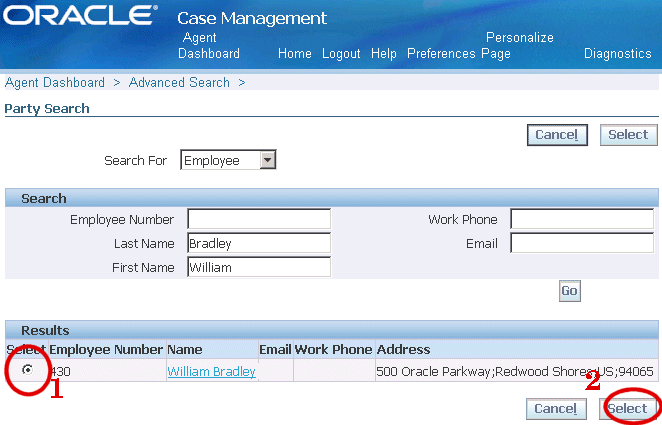
"William Bradley" appears in the Associated Parties region of the Advanced Search window.
-
Agent Crilly chooses the role for this associated party: "Witness".

-
Agent Crilly clicks Add Party to add the second associated party: the suspect Andre Smith to the search.
-
Agent Crilly chooses "Person" for Search For and enters Andre Smith in the Name field.
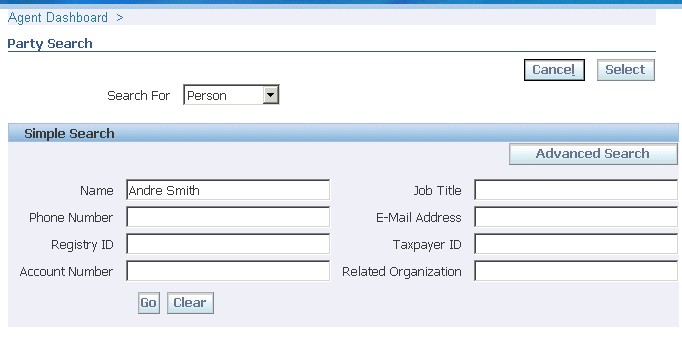
-
Clicking Go searches for all parties with a similar name. The application displays the result below.
-
Agent Crilly selects the party as shown below.
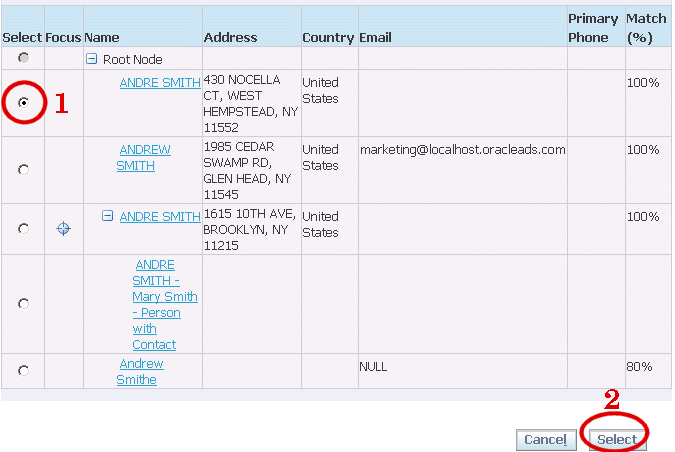
Andre Smith appears as the second associated party in the Advanced Search window.
-
Agent Crilly chooses the role: "Suspect".

-
And clicks Search.
The application displays the result of the search below. William Bradley is involved as a witness and Andre Smith as a suspect in case 58662: the security investigation involving the possession of a knife at the airport security gate.

Saved Searches
You can save your advanced search criteria for reuse. Agents can use saved searches to track service requests of a colleague who left on vacation, for example, or to track open cases for their work team.
To create a saved search, perform an advanced search and click Save Search As on the results page. You can also save the search criteria from the Maintain Saved Searches page and save it. You can choose to associate the saved search criteria either with all users or with selected responsibilities. When you associate the search with all users or selected responsibilities, the search becomes centrally defined. In the former case, the search is displayed for all users but when you map the search only to certain responsibilities, then only users under that responsibility can view the search criteria.
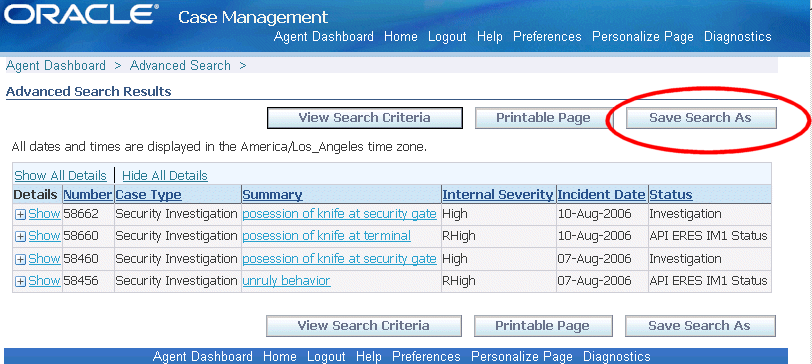
The Create Saved Search page makes it possible for you to name the search and to modify the display of results or the search criteria themselves. (The image below shows part of the page only).

Saved searches appear on the Agent Dashboard right underneath Quick Find.

Application Search
An agent can search for a service request from the Application Search region in the Agent Dashboard. The agent must select Cases from the Enterprise Search LOV, enter a keyword, and click Go. The application displays the results on the Apps Search Results page. The agent can further narrow down the search by using the filter criteria provided. The agent can then click on the Service Request number, to view or update the service request details in the Update Service Request page.
Creating and Updating a Task
This example illustrates the creation and updating of a task for a case regarding a suspect.
-
In the My Cases queue, Agent Crilly goes to the case regarding the suspect and clicks the Case Summary link.
-
He clicks the Tasks and Related Information tab to create a task to follow up the case with Mr. Bradley who was the witness for the case. He chooses "Follow Up Action" from the Create Task of Type list and clicks Go.
-
He sets the time zone to agent time zone to accurately identify the start and finish times for the job.
-
He enters "Follow up with Mr. Bradley" as the subject and the address of the place where the witness lives in the address.
-
As the investigation may take approximately 2 hours, he enters 2 as the planned effort and selects hours from the list and changes the status of the task to Assigned.
-
Next she selects the Task Closure Required to ensure that the service request is not closed before this task is closed.
-
Then he assigns the task to Mr Phillips, another investigator belonging to the group "Legal Team" and schedules the task in his queue.
The resources displayed in the list are based on the value set in the Service: Filter Task Assignee LOV by the Task Owner Group" profile. If this profile is set to Yes, the Assignee is filtered based on the owner group.
-
Next, Mr. Phillips opens the Agent Dashboard to view his work on hand. To view all his work assignment locations, he clicks Show Tasks on Map at the top of the My Tasks table. This displays the Google Map showing five locations with the respective tasks that are assigned to him.
-
He opens the first task in the update mode and accepts the new task assignment.
-
He views that the case was logged for a suspect held at gun point and the task is to get further information on the case from Mr. Phillips.
-
He updates the task status to Completed. Mr. Phillips will not be able to make any further updates to the task, as this status disables him from making any further changes to the task.
Searching for Tasks
Task search offers a wide variety of search criteria to search for tasks related to a service request.
For example, an agent can use task search to find all tasks created within the last week or owned by Mary Swanson. Or the customer may call regarding tasks for service request 9909. The agent then clicks the Task Search link in the Agent Dashboard and enters 9909 as the service request number. All tasks pertaining to the service request are displayed in the results region.
To start Tasks Search, click the Task Search link in the Agent Dashboard. The Tasks Search page is displayed. You can search for tasks based on the following attributes:
-
Task Attributes
You can search for tasks based on most of the task details including the task type, service request number, task number, status, and priority. You can also view the parent task associated with a task, if any. You can also search on customer information related to a task including name, account, and number.
You can select any of the following options to narrow the search results:
-
Show Only Open Tasks – Select this check box to display only tasks that are open
-
Show Only Escalated Tasks – Select this check box to display tasks that have been escalated. This is helpful in finding tasks on which immediate action is required.
-
Show Tasks for Escalated Service Requests Only – Select this check box to find tasks only on service requests that have been escalated. The results may include open, closed, or escalated tasks.
-
-
Subject and Description
You can search for tasks based on the subject and description of the service request.
For example, you can search for tasks related to the subject "Monitor not working". This may be helpful in identifying crucial tasks that were performed for resolving a service request in the past and using the same tasks to resolve the current service request.
-
Owner
You can find tasks based on the owner of the task. The owner may be yourself, your group or your team members, or your group or team. If you do not know the owner, you can also select the Any option.
-
Assignee
You can search tasks based on whom the task is assigned to. For example, if Mary Swanson is owner of tasks A, B, and C and she is on vacation from 12th to 20th July and has tasks that have been escalated and assigned to her, then you can select the Show Only Escalated Tasks option in the Task Attributes section and then select Others in the Assignee region and the type as Employee Resource and enter Ms. Swanson, Mary as the Name.
-
Task Dates
You can find tasks based on a specified duration. You can use the planned, scheduled and actual start and end dates to search for tasks.
Saving Task Search
Agents can save the advanced search criteria for reuse. They can use them to track tasks created for a specific customer or for an item, or to the person to whom the task was assigned, or tasks created during a specific period.
To create and save task search criteria, click Create Saved Search on the Agent Dashboard or perform an advanced search and click Save Search As on the results page.